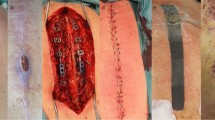Abstract
Objective
Surgical site infection (SSI) after cardiovascular procedures is a severe complication, potentially leading to high morbidity and mortality. In addition, during the treatment of SSI, rehabilitation is delayed, which can severely impair postoperative recovery. The aim of this study was to assess the effect of vacuum-assisted closure (VAC) therapy on rehabilitation during the treatment of SSI after cardiovascular surgery.
Methods
From January 2008 to March 2015, 10 patients underwent VAC therapy for SSI after cardiovascular operations. The patient characteristics, duration of VAC therapy, time interval from the implementation of VAC to physical therapy (PT) (T1), ambulation (T2) and walking (T3), functional independent measure (FIM), and maximum consecutive walking capacity (MCWC) were retrospectively analyzed.
Results
Nine patients underwent mid-sternal incision and one patient underwent thoraco-abdominal incision. The mean time interval from the beginning of VAC therapy to PT, ambulation, and walking was 0.38 ± 0.50, 0.63 ± 0.71, and 1.38 ± 1.86 days, respectively. The average FIM was 84.5 ± 14.0 at the beginning of VAC therapy and 106.7 ± 18.5 at the end of VAC therapy (P = 0.000494). On average, MCWC was 52.3 ± 54.6 m at the installation of VAC therapy and 189.7 ± 152.8 m at the completion of VAC therapy (P = 0.0169). FIM and MCWC improvement rate was better in VAC group than non-VAC group although these data are not suitable for statistical analysis because of a small sample size.
Conclusions
Although further studies are warranted, VAC therapy may have a role in facilitating rehabilitation and improving the prognosis of SSI cases after major cardiovascular operations.




Similar content being viewed by others
References
Simek M, Nemec P, Zalesak B, Kalab M, Hajek R, Jecminkova L, Kolar M. Vacuum-assisted closure in the treatment of sternal wound infection after cardiac surgery. Biomed Pap Med Univ Palacky Olomouc Czech Repub. 2007;151(2):295–9.
Vos RJ, Yilmaz A, Sonker U, Kelder JC, Kloppenburg GTL. Vacuum-assisted closure of post-sternotomy mediastinitis as compared to open packing. Interact Cardiovasc Thorac Surg. 2012;14:17–21.
Finkelstein R, Rabino G, Mashiah T, et al. Surgical site infection rates following cardiac surgery: the impact of a 6-year infection control program. Am J Infect Control. 2005;33:450–4.
Ridderstolpe L, Gill H, Granfeldt H, Ahlfeldt H, Rutberg H. Superficial and deep sternal wound complications: incidence, risk factor and mortality. Eur J Cardiothorac Surg. 2001;20:1168–75.
Suzuki T, Kawamoto Shunsuke, Motoyoshi N, Akiyama M, Kumagai K, Adachi O, Hayatsu Y, Ito K, Matsuo S, Saiki Y. Contemporary outcome of the surgical management of prosthetic graft infection after a thoracic aortic replacement: is there a room to consider vacuum-assisted wound closure as an alternative? Gen Thorac Cardiovasc Surg. 2015;63:86–92.
Mangram AJ, Horan TC, Pearson ML, Silver LC, Jarvis WR. Guideline for prevention of surgical site infection. Centers for disease control and prevention (CDC) hospital infection control practices advisory committee. Am J Infect Control. 1999;27:97–132.
Fuchs U, Zittermann A, Stuetten B, Groening A, Minami K, Koefer R. Clinical outcome of patients with deep sternal infection managed by vacuum-assisted closure compared to conventional therapy with open packing: a retrospective analysis. Ann Thorac Surg. 2005;79:526–31.
Fleck TM, Fleck M, Moidl R, et al. The vacuum-assisted closure system for the treatment of deep sternal wound infection after cardiac surgery. Ann Thorac Surg. 2002;74:1596–600.
Immer FF, Durrer M, Muehlemann KS, Erni D, Galh B, Carrel TP. Deep sternal infection after cardiac surgery: modality of treatment and outcome. Ann Thorac Surg. 2005;80:957–61.
Sjogren J, Malmsjo M, Gustafsson R, Ingemansson R. Poststernotomy mediastinitis: a review of conventional surgical treatments, vacuum-assisted closure therapy and presentation of the Lund University Hospital mediastinitis algorithm. Eur J Cardiothorac Surg. 2006;30:898–905.
Sjogren J, Gustafsson R, Nilsson J, Malmsjo M, Ingemansson R. Clinical outcome after poststernotomy mediastinitis: vacuum-assisted closure versus conventional treatment. Ann Thorac Surg. 2005;79:2049–55.
Higashita R, Asai T, Shiraishi S, Matsubayashi K, Nishi T, Kurokawa M. Vacuum-assisted closure for infections after cardiovascular surgery. Jpn J Cardiovasc Surg. 2006;35:127–31.
Wackenfors A, Sjoegren J, Gustafsson R, Algotsson L, Ingemannsson R, Malmsjo M. Effects of vacuum-assisted closure therapy on inguinal wound edge microvascular blood flow. Wound Repair Regen. 2004;12:600–6.
Kawata M, Nishimura T, Hoshino Y, Kinoshita O, Hisagi M, Ando M, Morota T, Motomura N, Kyo S, Ono M. Negative pressure wound therapy for left ventricular assist device-related mediastinitis: two case reports. J Artif Organs. 2011;14(2):159–62.
Kinoshita O, Nishimura T, Kawata M, Ando M, Kyo S, Ono M. Vacuum-assisted closure with Safetac technology for mediastinitis in patients with a ventricular assist device. J Artif Organs. 2010;13(2):126–8.
Author information
Authors and Affiliations
Corresponding author
Ethics declarations
Conflicts of interest
All the authors declare that no conflicts of interest exist.
Rights and permissions
About this article
Cite this article
Yoshimoto, A., Inoue, T., Fujisaki, M. et al. Efficacy of vacuum-assisted closure therapy on rehabilitation during the treatment for surgical site infection after cardiovascular surgery. Gen Thorac Cardiovasc Surg 64, 464–469 (2016). https://doi.org/10.1007/s11748-016-0664-x
Received:
Accepted:
Published:
Issue Date:
DOI: https://doi.org/10.1007/s11748-016-0664-x




